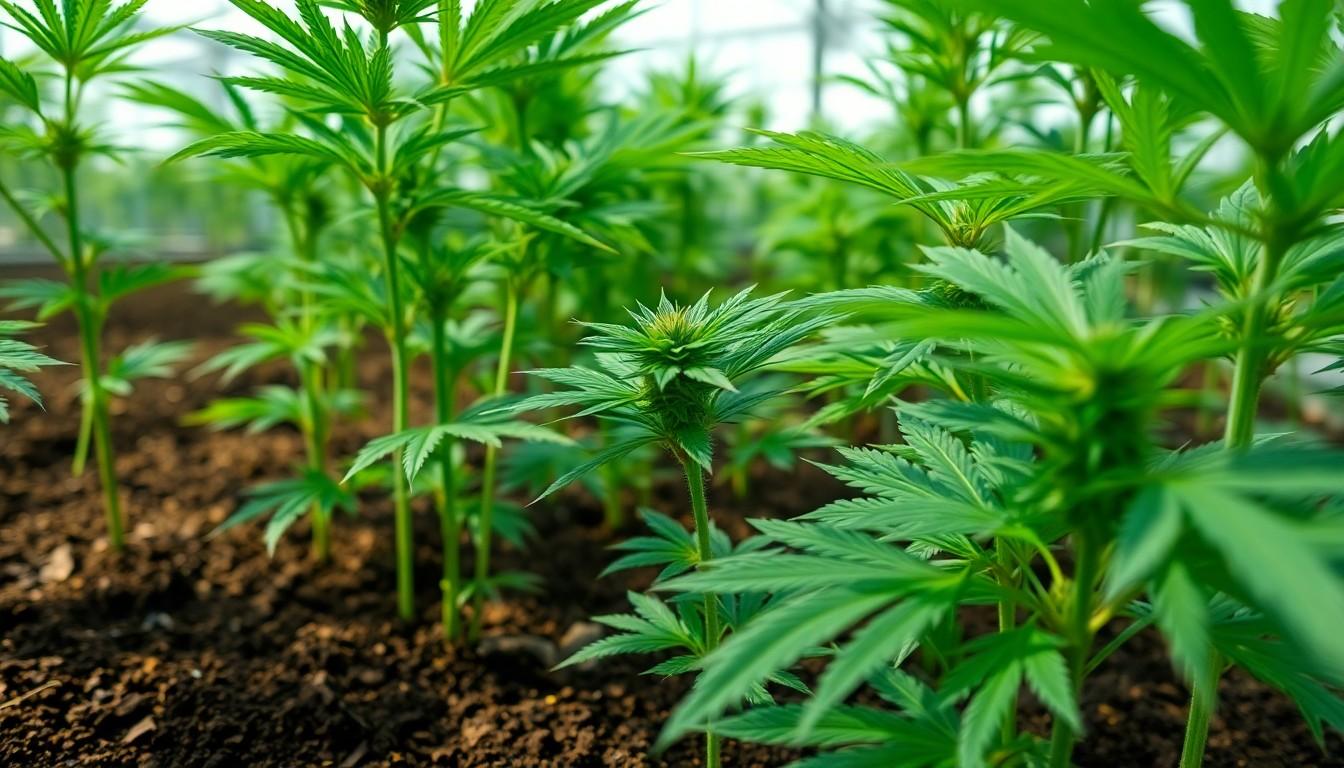Growing cannabis can feel like a walk in the park—until pesky plant diseases crash the party. Just when you think your green babies are thriving, along comes a sneaky fungus or a relentless pest ready to spoil the fun. Understanding these diseases isn’t just for the green-thumbed; it’s essential for anyone looking to cultivate a healthy and bountiful crop.
Overview Of Cannabis Plant Diseases
Numerous cannabis plant diseases can significantly impact growth and yield. Fungal infections like powdery mildew and root rot often pose substantial challenges. Bacterial pathogens such as bacterial wilt hinder plant health and productivity.
Viral diseases, including cannabis mosaic virus, spread rapidly and severely affect crops. Symptoms often manifest through discoloration and deformation in leaves, stunting overall growth.
Environmental factors contribute to disease susceptibility. High humidity levels typically facilitate fungal growth, while inadequate drainage can lead to root problems. Understanding these dynamics aids in preventing outbreaks.
Implementing integrated pest management strategies proves essential for combating these threats. Regular inspections, maintaining proper sanitation, and employing resistant strains serve as proactive measures.
Monitoring nutrient levels and environmental conditions lays a solid foundation for healthy plants. Proper ventilation and air circulation reduce the risk of fungal diseases. Growers can also benefit from utilizing organic fungicides and bactericides for treatment.
Awareness of the signs and symptoms of these diseases facilitates early intervention. Quick response minimizes damage and promotes healthier plants. By acquiring knowledge about these common diseases, cultivators can ensure robust cannabis production.
Common Cannabis Plant Diseases

Understanding cannabis plant diseases is vital for maintaining a healthy crop. Various diseases can impede growth, reduce yield, and affect quality.
Fungal Infections
Fungal infections pose a significant risk to cannabis plants. Common types include powdery mildew and root rot. Powdery mildew appears as white, powdery spots on leaves, indicating high humidity levels. Root rot affects the plant’s root system, often caused by overwatering or poor drainage. Symptoms may include wilting and yellowing leaves. Treatment options involve improving airflow, reducing humidity, and applying organic fungicides. Maintaining a clean growing environment minimizes the spread of fungal spores.
Bacterial Infections
Bacterial infections can lead to severe damage in cannabis cultivation. Bacterial wilt is one of the most notorious, causing rapid wilting and yellowing of leaves. It often spreads through contaminated tools and soil. Identifying this infection early is crucial for preventing widespread crop loss. The use of resistant strains and proper sanitation practices can help mitigate risks. Strict hygiene during plant handling prevents the introduction of bacteria. Regular inspections allow growers to catch infections early.
Viral Infections
Viral infections can severely impact cannabis growth. The cannabis mosaic virus is a well-known example, leading to mottled and distorted leaves. Infected plants often show stunted growth and reduced yield. These viruses typically spread through pests like aphids or by sharing tools. Prevention includes using virus-free seeds and controlling pest populations. Monitoring the health of plants regularly aids in early detection. Implementing robust biosecurity measures protects against viral threats.
Symptoms And Identification
Identifying cannabis plant diseases is crucial for maintaining plant health. Symptoms often serve as the first line of defense against disease progression.
Visual Symptoms
Discoloration in leaves usually indicates stress or disease. Yellowing leaves might signal nutrient deficiencies or root rot. Dark, water-soaked spots can suggest bacterial infections like bacterial wilt. Wilting plants often experience root issues or fungal infections. Curled or distorted leaves typically point to viral infections, such as cannabis mosaic virus. Powdery mildew presents itself as a white, powdery coating on leaves. Early detection of these visual cues enables timely intervention.
Diagnostic Techniques
Utilizing lab tests can provide precise identification of pathogens. Microscopic examination helps detect fungal spores or bacterial cells on affected tissues. Leaf tissue assays can isolate viral RNA to confirm viral infections. Soil testing assesses nutrient levels and pathogen presence in the root zone. Visual inspection remains vital to spot early symptoms and diagnose potential issues. Environmental monitoring helps identify conditions that favor disease outbreaks. Combining these techniques enhances disease management by facilitating effective intervention strategies.
Prevention And Management
Effective prevention and management of cannabis plant diseases incorporates various strategies, including cultural practices and chemical treatments.
Cultural Practices
Cultivators should prioritize cultural practices to enhance plant health. Implementing crop rotation reduces the buildup of pathogens in the soil. Maintaining proper spacing between plants ensures good airflow, reducing humidity levels conducive to fungal infections. Regularly inspecting plants for signs of disease facilitates early detection. Additionally, using sterile tools and maintaining clean growing environments significantly limits the spread of pathogens. Employing resistant strains offers another layer of protection against specific diseases. Correctly adjusting nutrient levels fosters robust plant growth, making them less susceptible to infections.
Chemical Treatments
Chemical treatments serve as an important tool for managing cannabis diseases. Organic fungicides provide effective control against fungal infections like powdery mildew and root rot. Utilizing bactericides can target bacterial pathogens such as bacterial wilt, helping to curb rapid damage. Application of these chemicals should follow guidance from product labels to ensure safety and efficacy. While chemical options exist, environmental impact must also be considered. Integrated use of both cultural and chemical methods optimizes disease management strategies, ensuring healthier crops. Monitoring the effectiveness of treatments ensures adjustments can be made as needed to maintain plant health.
Conclusion
Understanding cannabis plant diseases is vital for successful cultivation. Growers must stay vigilant and proactive to protect their crops from various threats. By implementing integrated pest management strategies and maintaining a keen eye on environmental conditions, they can minimize the risk of disease outbreaks.
Utilizing resistant strains and practicing good sanitation can further enhance plant health. Regular monitoring and early intervention are key to ensuring robust growth and optimal yields. With the right knowledge and practices, cultivators can navigate the challenges posed by diseases and enjoy a thriving cannabis garden.

